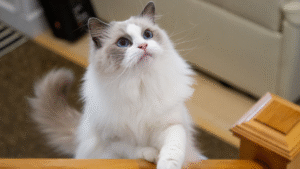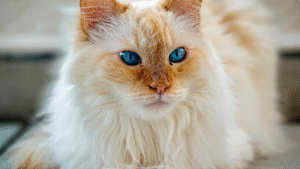Ragdoll cats are one of the most popular breeds in the world — and for good reason. They’re big, beautiful, and affectionate, making them great family pets for those willing to give them the time and love they need. But with their striking blue eyes and luxurious semi-long coats, they’ve developed a reputation for being high-maintenance.
So the question is: Are Ragdoll cats really that much work? Are they high maintenance? Is the Ragdoll breed worth it? As is often the case, the truth lies somewhere in the middle.

The Ragdoll Cat’s Personality
It’s helpful to understand the Ragdoll’s temperament before diving into their care needs. Their personality is best summed up by their nickname — “puppy-like cats.”
These cats love following their owners around the house, greeting them at the door, and even playing fetch. Ragdolls are calm, docile, and affectionate. They’re people-oriented, thrive on human interaction, and rarely entertain themselves for long.
On the flip side, because they depend heavily on their humans for stimulation and company, Ragdolls don’t handle being left alone for extended periods. In fact, many become lonely, bored, or even depressed if their owners are frequently away from home.
So yes, Ragdolls can be considered high-maintenance when it comes to their social and emotional needs. If you’re often out during the day or can’t spend much time with your pet, another breed might be a better fit.
Are Ragdolls Difficult to Groom?
One of the most common questions people ask when considering a Ragdoll is whether they’re difficult to groom. The short answer is no — Ragdolls are moderate maintenance at best in terms of grooming.
Their thick, silky fur is actually quite easy to care for. They have a soft, rabbit-like coat that sheds very little and lacks the dense undercoat that causes matting and tangles in breeds like the Persian or Maine Coon.
That said, Ragdolls still require regular brushing, cleaning, and nail trimming like any other cat. To keep their coats in top condition, brush them two or three times per week. This helps prevent matting, reduces shedding, and keeps their fur shiny and healthy.
During the spring and fall shedding seasons, you may need to increase brushing to daily sessions. Weekly eye and ear cleaning, nail trimming, and tooth brushing are also recommended.
In summary, Ragdoll grooming needs are moderate — not as demanding as other long-haired breeds but not as effortless as short-haired cats either.
Related:10 Most Popular Cat Breeds
Ragdoll Cat Diet
As with all cats, nutrition plays a major role in Ragdoll cat care. Ragdolls are large, muscular cats that take longer to mature, often continuing to grow until about four years of age.
Because of this, they need a high-quality, protein-rich diet to fuel their growth and maintain muscle mass. Look for cat foods that list real meat as the first ingredient, and avoid brands heavy in grains or fillers.
Wet food is an excellent option to keep your Ragdoll hydrated, as cats are naturally poor water drinkers.
Weight management is another key consideration. Ragdolls love lounging and relaxing, so their easygoing nature can lead to obesity if they’re overfed or under-exercised.
Obesity is a serious issue that can lead to diabetes, joint problems, and other health complications. It’s essential to maintain a healthy diet and encourage regular activity to keep your Ragdoll in good shape.
Play and Exercise
You might wonder, “If Ragdolls are calm and low-energy, how much exercise do they need?”
While they’re not as active as breeds like Bengals or Abyssinians, Ragdolls still need daily playtime to stay physically and mentally stimulated.
Play sessions don’t just mean chasing a ball or string. These intelligent cats respond well to training and enjoy activities that challenge their minds. Teaching them to walk on a leash, playing hide-and-seek, or using interactive toys and puzzles are great ways to keep them entertained.
Don’t be fooled by their laid-back nature — Ragdolls can surprise you with bursts of energy, stalking, and pouncing like little panthers when properly motivated.
Aim for 15–30 minutes of activity daily to prevent boredom and lethargy. Otherwise, you may find yourself wondering, “Are Ragdoll cats lazy?”

Ragdoll Cat Health
Ragdolls are generally healthy cats, but like all purebreds, they can be prone to certain genetic conditions. Responsible breeders test for these issues before breeding. Common concerns include:
-
Hypertrophic Cardiomyopathy (HCM) — a common heart condition in cats
-
Polycystic Kidney Disease (PKD) — affects kidney function
-
Bladder stones and urinary issues
Regular veterinary care is crucial. Annual checkups, vaccinations, dental cleanings, and parasite prevention help ensure your Ragdoll’s long-term well-being.
A balanced diet and plenty of water are also essential. Because Ragdolls are large cats, they need the right nutrients and portion control to stay healthy without becoming overweight.
Emotional Needs
This is the real question behind “Are Ragdoll cats high maintenance?” — their emotional needs.
Ragdolls are exceptionally affectionate and people-oriented. They crave companionship and often want nothing more than to be near their humans. They dislike being ignored and will follow you from room to room just to stay close.
Ragdolls are also devoted lap cats. They love to stretch out or flop across your lap, sometimes going completely limp when picked up — the very behavior that inspired their name.
If you’re looking for an independent cat that’s content spending hours alone, a Ragdoll might be too demanding. But if you want a loyal, loving, and affectionate companion, this breed will be a perfect match.
Living Environment
Ragdolls are strictly indoor cats. Their trusting, laid-back personalities make them ill-equipped for outdoor life. They lack strong territorial instincts and survival skills, which can put them at risk if allowed to roam freely.
Instead, create an enriched indoor environment. Ragdolls love vertical spaces — cat trees, perches, and shelves where they can observe their surroundings.
Provide plenty of cozy sleeping areas, soft blankets, and comfortable spots near family members. If you’d like to give them a taste of the outdoors, consider a secure catio or supervised harness walks, but never unsupervised outdoor access.

Time Investment
When most people ask, “Are Ragdoll cats high maintenance?” what they really want to know is, “Do they take a lot of time?”
The answer is yes and no. Ragdolls aren’t particularly difficult in terms of grooming, feeding, or exercise, but they do require consistent attention and daily interaction.
These affectionate cats dislike being left alone and can become depressed if neglected. If you can dedicate time each day for brushing, play, and affection, caring for a Ragdoll will be a joy rather than a chore.
Ragdolls also have a long lifespan — typically 12–16 years or more — so adopting one is a long-term commitment.
Ongoing Care and Costs
Beyond the initial cost of purchasing or adopting a Ragdoll, you’ll need to budget for ongoing expenses such as:
-
High-quality cat food
-
Grooming tools and supplies
-
Veterinary care and/or pet insurance
-
Litter and litter boxes
-
Toys and enrichment items
These cats will be part of your family for many years, so it’s important to plan for their long-term care and comfort.
The Bottom Line on Ragdoll Cat Maintenance
So, are Ragdoll cats high maintenance? The short answer is no — but they’re not completely low-maintenance either.
Ragdolls require a reasonable amount of grooming and attention each day, but they’re not overly demanding. They’re easygoing and adaptable, yet they thrive best with plenty of companionship and interaction.
If you love big, beautiful, affectionate cats and have time to dedicate to their care, Ragdolls make wonderful pets. However, if you prefer an independent, low-maintenance cat that doesn’t require much attention, a Ragdoll might not be the right fit.
- Homemade Calming Spray To Help Dogs During Training - November 12, 2025
- 7 DIY Dog Training Tools You Can Make From Household Items - November 12, 2025
- How To Make Your Own Clicker For Dog Training - November 12, 2025
